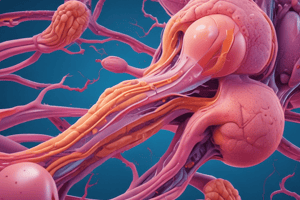Podcast
Questions and Answers
What is the function of the prostate gland?
What is the function of the prostate gland?
- Assistance in maintaining urinary control (correct)
- Facilitation of erection during sexual activity
- Production of sperm in the testes
- Protection of the testes
Which fluid mixes with sperm and other fluids to form semen during ejaculation?
Which fluid mixes with sperm and other fluids to form semen during ejaculation?
- Prostatic fluid (correct)
- Saliva
- Blood
- Urine
What part of the penis becomes enlarged during an erection?
What part of the penis becomes enlarged during an erection?
- Glans
- Shaft (correct)
- Pelvic bone
- Root
How does the penis return to its normal state after ejaculation?
How does the penis return to its normal state after ejaculation?
What provides nutrients for the survival of sperm cells as they travel towards the egg?
What provides nutrients for the survival of sperm cells as they travel towards the egg?
Where are the testes located in the male reproductive system?
Where are the testes located in the male reproductive system?
What is the main function of the testes in the male reproductive system?
What is the main function of the testes in the male reproductive system?
Which organ is responsible for releasing semen from the male body?
Which organ is responsible for releasing semen from the male body?
What contributes to an erection in males during sexual arousal?
What contributes to an erection in males during sexual arousal?
Where is the prostate gland located in relation to the bladder?
Where is the prostate gland located in relation to the bladder?
Apart from sperm cells, what else is a major component of semen?
Apart from sperm cells, what else is a major component of semen?
Flashcards are hidden until you start studying
Study Notes
Male Reproductive System
The male reproductive system is responsible for producing sperm cells and delivering them from the body during sexual intercourse. This process involves several key components that work together to ensure successful reproduction. These include the testes, ejaculation, prostate gland, and penis.
Testes
Testes are two small organs located inside the scrotum, which can be found outside the pelvis in males. They play a crucial role in producing sperm cells. Each testicle contains thousands of tiny tubes called seminiferous tubules, where sperm cells are produced. In addition to sperm production, testes also produce hormones such as testosterone, which contributes to the development of secondary sex characteristics such as facial hair and a deep voice.
Ejaculation
Ejaculation is the release of semen from the body via the penis. Semen consists mainly of sperm cells produced by the testes, along with fluids from other sources like the prostate gland and seminal vesicles. The process of ejaculation starts when the penis becomes erect due to increased blood flow, allowing it to penetrate the female's vagina. Muscles in the lower abdomen and around the base of the penis contract, forcing semen out through the urethra and into the female's cervix.
Prostate Gland
The prostate gland is a walnut-sized organ located below the bladder, surrounding the upper part of the urethra. It produces a fluid component of semen called prostatic fluid, which provides nutrients for the survival of sperm cells as they travel towards the egg. During ejaculation, this fluid mixes with sperm from the testes and other fluids from accessory glands, forming semen. The prostate gland also plays a significant role in maintaining urinary control, particularly after puberty.
Penis
The penis is an external structure involved in both urination and sexual activity. It consists of three main parts: the root, which attaches the penis to the pelvic bone; the shaft, which extends upwards from the root and becomes enlarged during an erection; and the glans, which is the head of the penis. When stimulated, muscles in the penis fill with blood, causing it to become erect and facilitating penetration during sexual intercourse. After ejaculation, the penis returns to its normal state due to decreased blood flow and smooth muscle contractions in the Corpora cavernosa.
Studying That Suits You
Use AI to generate personalized quizzes and flashcards to suit your learning preferences.




